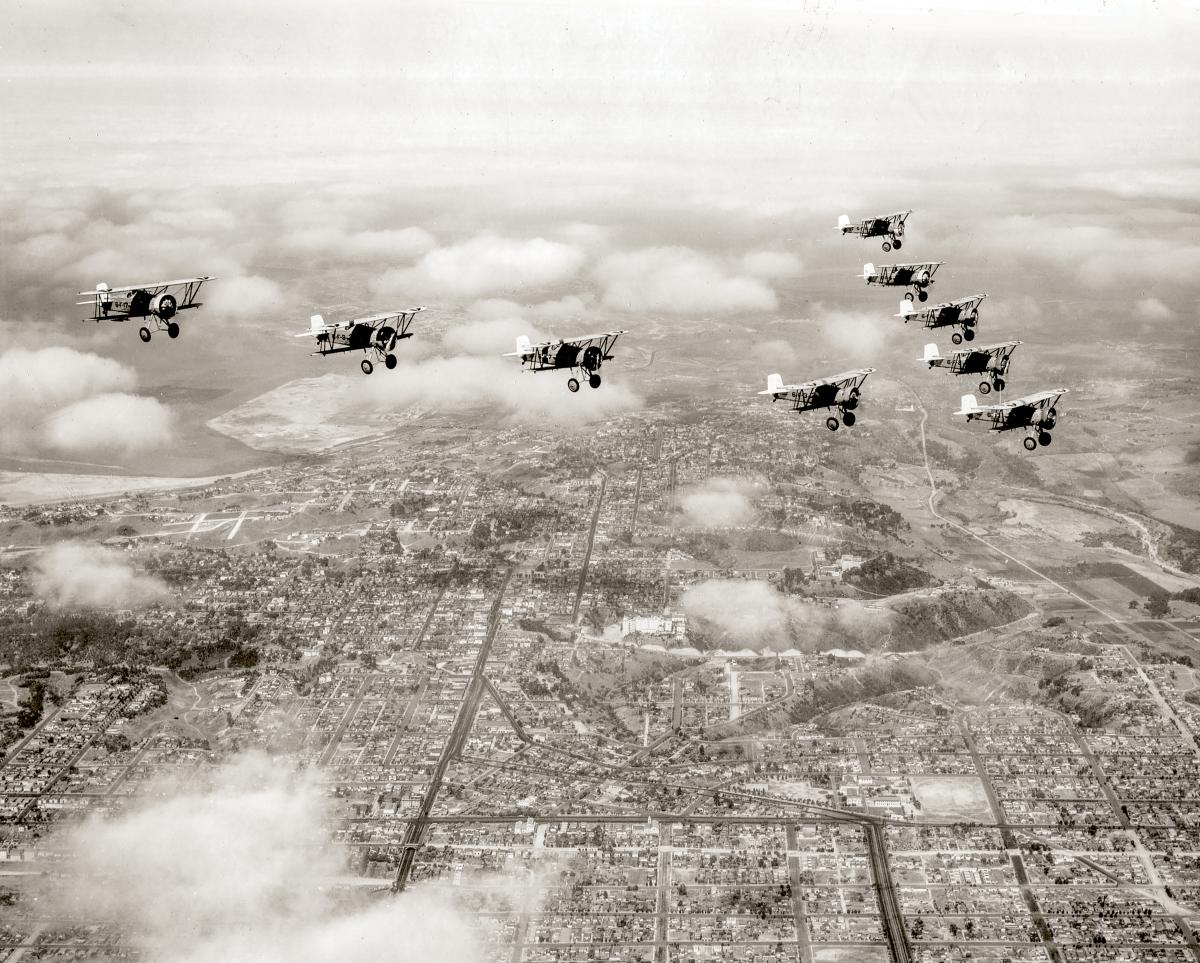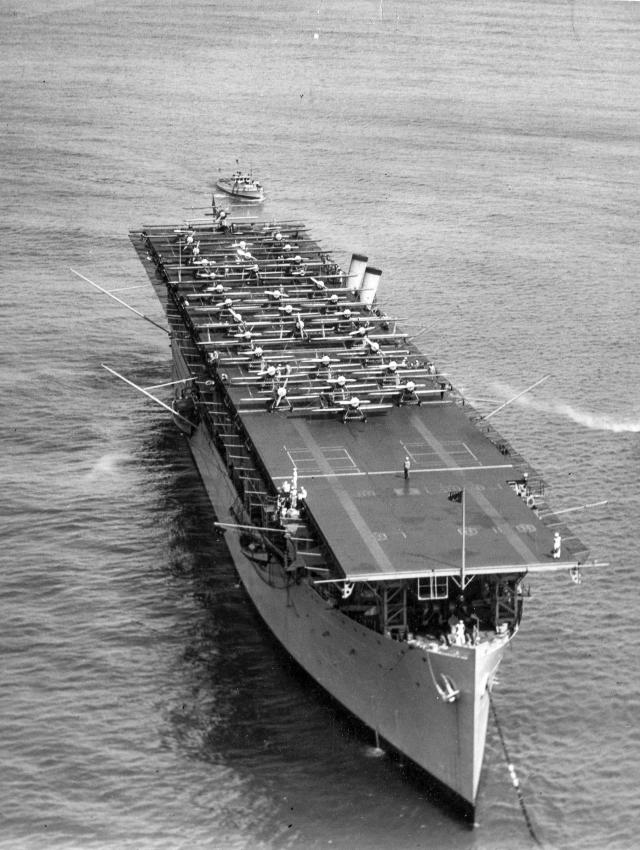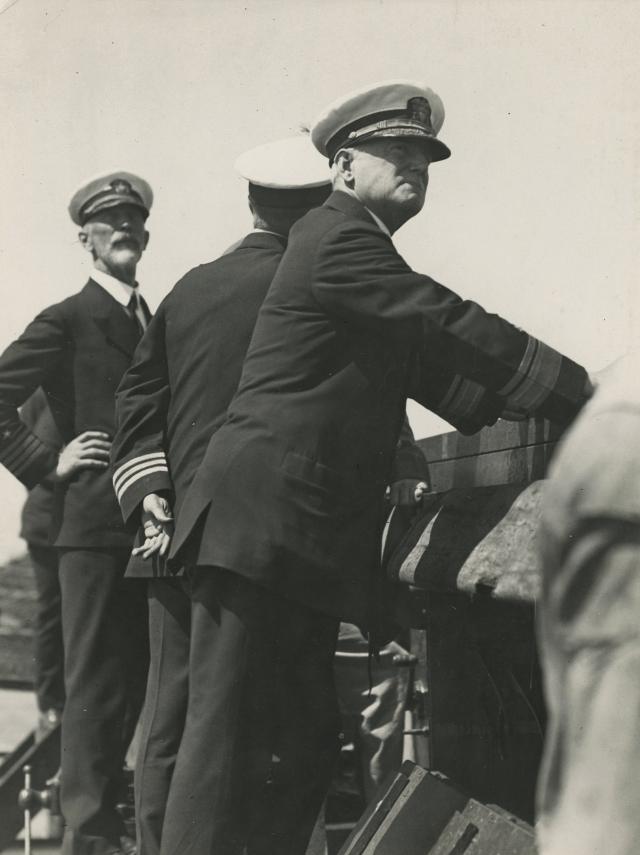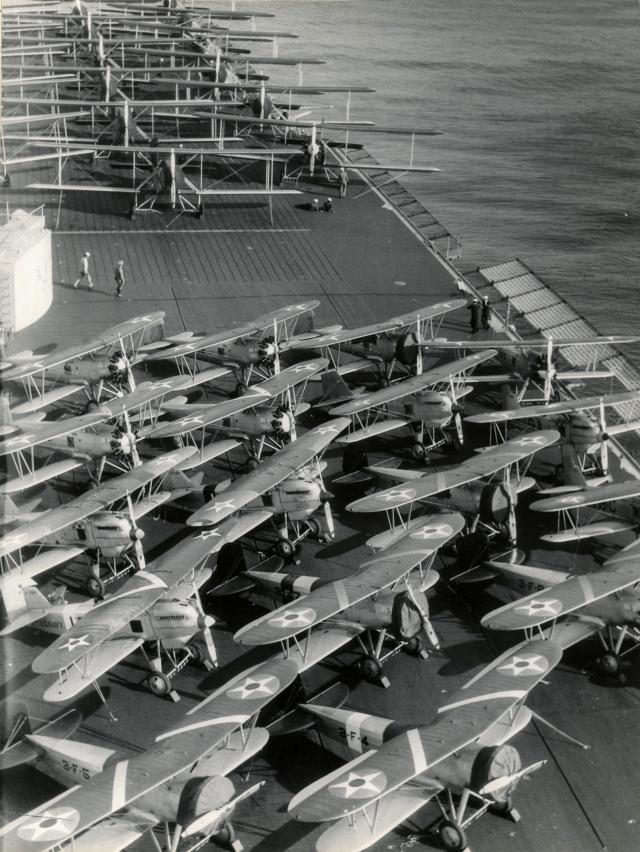For the past 50 years, the Navy’s carrier battle groups have operated with relative impunity because of their long-range strike capability, superior sensors, and preeminent defensive support. However, the age of offensive naval power is at hand. Modern technological advances have created a world in which offensive firepower can outpace, overwhelm, and outmaneuver sensors and defensive measures.
Over the past decade, advances in drones, long-range and hypersonic missiles, and directed-energy weapons have significantly increased risk for U.S. Navy units and decreased the effectiveness of current defensive capabilities. In the short-term, these threats will prove difficult—if not impossible—to counter with existing systems and doctrine. To mitigate this increased risk, the Navy must respond by adopting and incorporating this offensive weaponry and other new technologies into its warfighting doctrine.
The U.S. Navy has done so before. The advent of naval aviation in the interwar period created a similar expansion of offensive capabilities. The improvements in air power during that period destabilized the big-gun paradigm that defined pre–World War I naval engagements, creating opportunities for navies to take advantage of new technologies and capabilities. Unlike the British Royal Navy, which was slow in adopting naval aviation to project power, the U.S. Navy effectively integrated aviation into fleet doctrine during the 1920s and ̓30s. Its experimentation with and aggressive use of new technology and doctrine during this period should serve as a model for implementing new systems today.
U.S. Carrier Development
Technological innovations in aircraft and weaponry in the 1910s and ̓20s enabled a rapid increase in offensive firepower throughout the interwar period. This shifted the landscape of global naval power in a relatively short time. For example, during a span of roughly 25 years, the Royal Navy and its big-gun platforms went from the being preeminent naval power to being clearly outclassed by the U.S. and Japanese navies.
Throughout the interwar period, the U.S. Navy experimented and aggressively integrated different types of aircraft and weaponry into its fleet doctrine. This path did not come without organizational friction and resistance. Still, senior leaders were able to overcome bureaucratic inertia and implement reforms that advanced naval aviation. These steady advances in technology, tactics, and doctrine enabled the Navy to fight effectively in World War II and served as the foundation for modern naval combat.
Early Support for Naval Aviation
British experience with carriers in the 1910s greatly informed the U.S. Navy’s development of its own carriers. British experiments with ship-launched aircraft began in earnest in 1913, well before any significant U.S. interest. The cruiser HMS Hermes was modified to launch light biplanes from tracks fitted to her forecastle.1 Results were mixed; operations were not particularly efficient or effective, but the British experiments provided proof of concept.2 Indeed, a handful of senior officers operating with the Royal Navy during World War I saw the potential utility of naval aviation.3 However, on the whole, Royal Navy leaders remained staunchly in favor of traditional gunnery.4
Despite similar “initial foot dragging,” the U.S. Navy aggressively pursued naval aviation technologies and operational concepts.5 Early U.S. efforts were given a substantial boost by the work of renowned British naval engineer Stanley V. Goodall, who was loaned to the Navy’s Bureau of Construction and Repair in 1917. His work, heavily influenced by contemporary British designs, was the basis for the first U.S. carrier plans.6
In 1919, Congress authorized conversion of the collier Jupiter to the aircraft carrier Langley. Commissioned in 1922, and intended to be “no more than an experiment,” the USS Langley (CV-1) vaguely resembled the British carrier Argus with her large wooden deck and limited speed.7 Technologically, she did not feature any major improvements on British designs, but she served as a veritable proving ground for tactical innovation and doctrinal advances vis-à-vis the embarked aircraft.8
Following the Langley and the subsequent construction of more proficient carriers, developing naval aviation became a priority of naval leaders. In the summer of 1919, the Navy’s General Board decreed “aircraft have become an essential arm of the fleet,” and said improvement in naval aviation was “of paramount importance and must be undertaken immediately if the United States is to take its proper place as a naval power.”9 Despite the limited capabilities of existing aircraft, forward-thinking leaders such as Secretary of the Navy Josephus Daniels and Admiral William Sims recognized that airplanes could add unique offensive capabilities to the fleet. Secretary Daniels told Congress that there should be:
particular stress upon the importance of proper development of naval aviation at the present time. . . . It is obvious that our aim in this country should be to so develop naval aviation that the fleet may be in a position . . . to use this new weapon both offensively and defensively.10
This statement was in stark contrast to many conservative, battleship-focused leaders.11 As with the British Admiralty, many of them saw aircraft as tools of limited utility—primarily for scouting and gun-spotting. These views stemmed from concerns about the survivability and lethality of existing aircraft.
Despite this organizational friction, there was a thirst for further exploration of naval aviation’s offensive potential.12 In 1921, the Navy established the Bureau of Aeronautics (BuAer), with Rear Admiral William A. Moffett as its first leader. BuAer was given control of design, construction, and fielding of all aircraft for the Navy and Marine Corps. It also worked to create sustainable and attractive career paths for aviators, churning out large numbers of qualified pilots.13 As one author notes, “any senior officer who wanted a carrier command, or indeed any operational command in naval aviation, had to be a pilot.”14 Perhaps most important, BuAer had a culture of innovation where “[f]ailure was tolerated so long as it yielded productive results and precise information and accurate analyses about system performance.”15
For his part, Admiral Moffett was a bureaucratic savant and savvy political player.16 In the early days of BuAer, Moffett used his political connections to cultivate support in Congress and among the American public.17 His testimony on Capitol Hill significantly helped the cause of naval aviation, with one congressman calling a session of Moffett’s testimony to Congress a “masterpiece.”18 Equally important, Admiral Moffett also gladly accepted any support from the Navy’s battleship admirals and emphasized the utility of aircraft to spot and scout for the heavy guns.19
Some suggest that Moffett “disguised” his vision of carrier aviation’s offensive capability, so as “not to alarm the battleship admirals.”20 He initially presented aircraft carriers as supplementary to the heavy-gun battle line. This suggestion is supported by Moffett’s testimony to the House of Representatives Committee on Naval Affairs, in which he emphasized the usefulness of naval aviation in support of traditional elements of sea power. As a secondary consideration, he noted the value of carriers in “raiding operations.”21
As tactical naval air doctrine became more refined—combined with significant advances in aircraft capabilities—attention turned to the offensive potential of carriers. With aircrafts’ increased integration into fleet tactics, Moffett and BuAer were given an opportunity to make their case for the combat effectiveness of naval air power, and gained increasing acceptance from fleet leaders.
Doctrinal Advances
Perhaps the most important innovator in tactical naval aviation in the early 1920s was Joseph M. “Bull” Reeves. While at the Naval War College in the early 1920s, then-Captain Reeves served as head of the Tactics Department and established an innovation group to develop carrier warfare doctrine.22 In the mid-1920s, Moffett assigned Reeves as commanding officer of the Langley to test and evaluate carrier tactics.23 Recognizing that the carrier’s offensive potential was tied to her aircraft capacity, Reeves pushed to embark more strike aircraft and improve deckplate efficiency. Despite the safety concerns of some aviators, Reeves’ engineering and logistical innovations increased the embarked capacity from 12 planes to at least 42.24 Meanwhile, Reeves also dramatically increased the efficiency of takeoff and recovery, pushing the limits of what was thought possible. For example, during Fleet Problem VIII in 1928, the Langley launched 35 aircraft in 7 minutes, a remarkable feat to that point.25
While the Langley was a good platform for tactical improvements, her size and power made her less than ideal for warfighting or fleet exercises. The next two U.S. carriers were significant technological improvements. With naval tonnage limited by the Washington Naval Treaty, construction on two large, modern battle cruisers, the Lexington and Saratoga, was suspended. Instead of scrapping them because of the treaty obligations, the United States negotiated an exception that allowed the two ships to be converted to aircraft carriers.26 Both were very large and faster than any other ship in the U.S. Navy.27 More important, using the techniques and procedures established by Captain Reeves, each carrier could embark more than 80 aircraft.28 When the two ships joined the fleet in late 1927, they had a substantial impact on fleet exercises and contributed to the increasingly positive perception of naval aviation.
Perhaps the most striking display of the growth in naval aviation capabilities came in Fleet Problem IX in 1929. Newly promoted Rear Admiral Reeves commanded the USS Saratoga (CV-3) in an aggressive simulated attack on the Panama Canal.29 Operating independently of the main battle line, the Saratoga slipped past the defending force and launched 83 planes in a daring all-out aerial attack on the canal.30 Though the “Sara” was “sunk” numerous times after the launch, the bold strategy and simulated destruction illustrated carriers’ offensive potential—especially when operating independently.31 Despite protests from some battleship admirals, senior naval leaders took the lessons learned from Fleet Problem IX to heart. Top leadership, including Admirals Henry Wiley and William Pratt, heaped praise on Reeves’ operation.32 Perhaps more important, these fleet problems provided empirical data and hard evidence of success to naval aviation advocates.
Throughout the early 1930s, the United States continued to refine its carrier strategy and tactics to keep up with technological improvements in aircraft design and lethality.33 This strategy involved the organic and independent use of carriers and aircraft, which allowed them freedom to maneuver. The Royal Navy, by contrast, “grafted air power onto existing doctrine,” keeping the carrier “subordinate” to the fleet’s battleships.34 The U.S. Navy’s approach used carriers to support battleships, but it also allowed them to be a focal point—emphasizing independence from the main battle line.
Even so, by 1940, naval aviation was not necessarily the dominant player in U.S. naval strategy. Indeed, “to the extent that there was any shift in mind-set [among U.S. Navy leaders] it was toward deploying a balanced fleet, with neither the battleship nor aircraft carrier intrinsically favored as the capital ship of the future.”35 The advances made by Admiral Reeves and others, however, built institutional knowledge and latent capability. This capability—and the fleet balance that came with it—was crucial after the attack on Pearl Harbor in 1941, and it eventually enabled the U.S. Navy to achieve success against Japan in the Pacific.
Lessons Learned and Modern Applications
The development of carrier aviation in the interwar period can offer important lessons for maintaining superiority in today’s maritime environment. Modern technologies have created a similar expansion of offensive capabilities. The Navy risks being outpaced by the speed of these doctrinal and technological advances, such as artificial intelligence, long-range hypersonic missiles, and unmanned/autonomous weapons. Bureaucratic inertia, aversion to risk, and overconfidence in current capabilities present additional challenges. To maintain maritime superiority, the Navy must incorporate these new technologies and platforms into its strategy.
Perhaps the most basic lesson of the development of carrier doctrine is that change happens very quickly. In the span of 25 years, the Royal Navy went from having a commanding ability to project power to being significantly outclassed by the U.S. and Japanese navies and their advanced carrier tactics. During an even shorter span, the U.S. Navy went from fielding a small, underpowered experimental carrier in 1922 to the simulated destruction of the Panama Canal with a massive aerial attack in early 1929 during Fleet Problem IX.
The pace of today’s technological change is faster than ever before and affords the opportunity both to develop new capabilities and to fall behind. The Navy must not underestimate the speed at which potential adversaries can upgrade their capabilities and incorporate new platforms into their naval strategies. The People’s Republic of China has made great strides in nearly every significant naval category over the past ten years. In addition to its development of top-end missile technology, China’s aggressive island-building campaign in the South China Sea has significantly affected the strategic Japanese landscape in a short span of time.
At the very least, Navy leaders must understand that maritime superiority can be lost within a matter of years. An overly conservative approach, as taken by the Royal Navy in the interwar period, will lead to the underdevelopment of critical technologies and tactics. There must be a concerted effort to counter bureaucratic inertia and reward increases in efficiency. Commanders should be encouraged to push limits with new capabilities. Navy leaders should expect that some of these efforts will fail (sometimes spectacularly) and should seek to insulate tactical commanders from the blowback to promote innovation. In today’s 24-hour news cycle and under intense scrutiny from Congress, that is easier said than done. However, accepting these risks will be critical to maintaining U.S. naval superiority.
Fleet Balance
Through the 1930s and early ̓40s, many senior Navy leaders did not see the carrier as the capital ship of the future. Indeed, even the leaders who were supportive of naval aviation often did so because they sought a more balanced fleet—not one dominated by carriers. This fleet balance proved critical after the crippling attack at Pearl Harbor in 1941. The loss of many capital ships, while devastating, did not prove insurmountable. The development of naval aviation in the 1930s was essential to the Navy’s ability to recover and prosecute the war in the Pacific.
Today, the Navy has very little fleet balance at the capital-ship level. Nimitz- and Gerald R. Ford-class carriers, along with LHA and LHD amphibious assault ships (to an extent), are the primary capital ships of the Navy. Massive investments in time, resources, and manpower are required to build and operate these ships. Historically, carrier strike groups have operated with relative impunity because of their significant strike range and impressive defensive assets. As technology makes missiles and drones more lethal—with hypersonic or swarm capabilities—carrier strike groups will no longer be able to operate with such wide latitude. Defensive countermeasures are increasingly ineffective against such weaponry, and current sensor technology is inadequate to defend against these new threats.
As the lethality of offensive firepower—and prevalence of advanced missiles—increases, the carrier strike group’s ability to safely project power will be diminished. The loss of a single carrier would be a national disaster. Moreover, a loss of such a significant capital ship would create harsh political realities for national leaders—there would be little or no way to deescalate a conflict after a successful enemy attack on a carrier.
In the short term—until sensor technology and defensive countermeasures can catch up to the new threats—the Navy should strive for fleet balance that allows power projection without overreliance on carrier strike groups. Smaller surface combatants equipped with powerful offensive weapons cannot replace the firepower of a carrier’s air wing, but they can still pose a threat to opposing forces. A large number of small combatants will allow for more distributed lethality. Similarly, the Navy should emphasize the subsurface domain to avoid new threats on the surface. These are not new or novel concepts. However, the Navy must focus on their implementation and execution to stay ahead of potential adversaries.
As with carrier innovation and doctrinal advances during the interwar period, the Navy must test and experiment with new platforms that can provide balance to the fleet. Unmanned surface and subsurface vessels should be fielded as quickly as possible. Even if these systems are not fully mature or are deployed piecemeal, the fleet will be able to provide invaluable feedback for their continued development and refinement. These new platforms and capabilities must get into the hands of commanders and sailors at the earliest opportunity. Throughout the development of carrier aviation, fleet commanders and tactical-level sailors provided the most value—once they were allowed to. Today, the strategy should largely be the same: Give the sailors the platform and allow them to innovate.
1. The cruiser Hermes should not be confused with the British light carrier Hermes, which was commissioned in 1924. David Wragg, Carrier Combat (Annapolis, MD: Naval Institute Press, 1997), 6.
2. Wragg, Carrier Combat, 6. Claude Grahame-White and Harry Harper, Aircraft in the Great War: A Record and Study (London: T. Fisher Unwin, 1915), 157.
3. Millard S. Firebaugh, ed., Naval Engineering and American Sea Power (Dubuque, IA: Kendall/Hunt, 2000), 137.
4. Emily O. Goldman, The Diffusion of Military Technology and Ideas (Stanford, CA: Stanford University Press, 2003), 280–81.
5. Adam N. Stulberg, Michael D. Salamone, and Austin G. Long, Managing Defense Transformation (Burlington, VT: Ashgate Publishing Company, 2007), 101–2.
6. Paul Fontenoy, Aircraft Carriers: An Illustrated History of Their Impact (Santa Barbara, CA: ABC-CLIO, 2006), 38. Firebaugh, Naval Engineering, 132.
7. Fontenoy, Aircraft Carriers, 38.
8. Firebaugh, Naval Engineering, 133–34. The vessel did make minor improvements but at the time of commissioning, it was still small, slow, and had rudimentary takeoff and launch capabilities.
9. George W. Baer, One Hundred Years of Sea Power: The U.S. Navy, 1890–1990 (Stanford, CA: Stanford University Press, 1993), 141. Nathan Miller, The U.S. Navy: A History, 3rd ed. (Annapolis, MD: Naval Institute Press, 1997), 200–1.
10. Congressional Testimony of Josephus Daniels, 6 March 1920, House of Representatives Committee on Naval Affairs, 2,245.
11. CAPT L. M. Overstreet, USN, “Naval Strategy as Affected by Aircraft and Battleships,” Outlook (1923): 130.
12. Congressional Testimony of Josephus Daniels. See also Congressional Testimony of William Moffett, 30 January 1928, House of Representatives Committee on Naval Affairs.
13. Lisle A. Rose, Power at Sea (Columbia, MO: University of Missouri Press, 2007), 178.
14. Paul Beaver, The British Aircraft Carrier (Wellingborough, UK: Patrick Stephens, 1984), 20–21.
15. Rose, Power at Sea, 178.
16. Robert G. Albion, Makers of Naval Policy 1798–1947 (Annapolis, MD: Naval Institute Press, 1980), 374–75.
17. Robert W. Love Jr., History of the U.S. Navy, 1775–1941 (Harrisburg, PA: Stackpole, 1992), 550–51. This political support came in handy to fight off one last attempt by Brigadier General William “Billy” Mitchell to consolidate air power into an independent service. Moffett argued to President Calvin Coolidge’s Morrow Commission that, despite some duplication between the Navy and War Departments, interservice competition would drive innovation. In 1925, the Morrow Commission decided the issue once and for all—the Navy would retain control over naval aviation.
18. Congressional Testimony of William Moffett, 30 January 1928.
19. Baer, One Hundred Years of Sea Power, 141.
20. Terry C. Pierce, Warfighting and Disruptive Technologies (New York: Frank Cass, 2004), 127.
21. Congressional Testimony of William Moffett, 30 January 1928, 1,025–26.
22. Pierce, Warfighting and Disruptive Technologies, 124.
23. Pierce, 124.
24. Norman Polmar, Aircraft Carriers: A History of Carrier Aviation and its Influence on World Events (Washington, DC: Potomac, 2006), 49. Commander Eugene Wilson, Reeves’ chief of staff, noted that the officers on board the Langley doubted that more than 12 aircraft could be embarked safely.
25. Polmar, Aircraft Carriers, 49.
26. Fontenoy, Aircraft Carriers, 39.
27. Firebaugh, Naval Engineering, 134
28. Rose, Power at Sea, 187.
29. Rose, 187.
30. Polmar, Aircraft Carriers, 55–56.
31. Rose, Power at Sea, 187.
32. Polmar, Aircraft Carriers, 56.
33. Love, History of the U.S. Navy, 590. The death of Rear Admiral Moffett in an airship crash was a great loss for BuAer and the entire Navy. However, his successor, Rear Admiral Ernest J. King, was a similarly dynamic figure.
34. Goldman, The Diffusion of Military Technology and Ideas, 281.
35. Stulberg et al., Managing Defense Transformation, 111.






